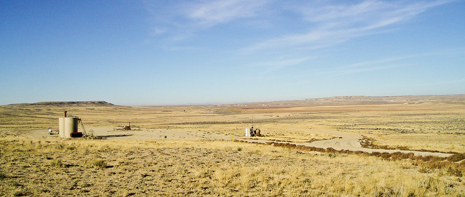 |
|
Wind Dancer field is located southeast of the Pinedale anticline in southern Wyoming. Image courtesy of GMT Exploration.
|
|
As exploration and development operations continue to ramp up in unconventional plays—especially in fields with complex, multistage fracture completions—operators often experience underperforming wells and undergo long learning curves attempting to understand how best to optimize production.
Taking a trial-and-error approach, for example, companies developing tight gas reservoirs have drilled dozens of wells and spent millions of dollars while making incremental changes to various completion parameters, seeking to discover the optimal solution. Without an appropriate data gathering and modeling strategy, however, it can prove exceptionally difficult to determine whether an underperforming frac is due to improper completion design or to lower local reservoir quality.
To evaluate completion effectiveness and reservoir properties for an underperforming multilayer tight gas development in Wind Dancer field of southwestern Wyoming (Fig. 1), GMT Exploration engaged Schlumberger Data and Consulting Services. A multidisciplinary team with extensive knowledge and experience in these types of plays performed single-well evaluations using integrated petrophysical and geomechanical models to identify optimization opportunities. Strategic modifications to current completion practices resulted in quantifiable gains in well productivity.
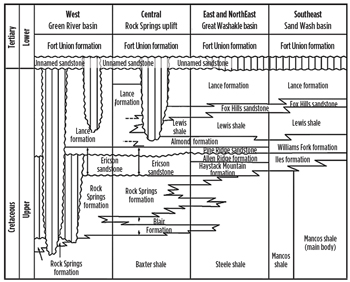 |
|
Fig. 1. Southwestern Wyoming stratigraphic column.
|
|
PHASE ONE: LOOK-BACK STUDY
The primary targets of this study were the Upper Cretaceous Mesaverde group and turbidites within the overlying Lewis shale. Four horizons in the Rock Springs, Almond and Lewis formations had been completed in up to seven frac stages at depths of 10,000–13,000 ft TVD, with each stage treating two to five low-permeability sands of limited areal extent.
Strategic data gathering. In the rush to bring wells online, some operators may not acquire sufficient high-quality wellbore data up front, when they first enter a new play, to properly model and characterize reservoirs. While others may capture these data, they may not use them in predictive models to fully understand reservoir variations. Even fewer perform fracture simulation and modeling based on rock mechanics. Thus, they rarely build the integrated, multidomain models necessary to accurately evaluate or design complex multistage fracture completions.
In Wind Dancer field, however, quality well information was available for multi-disciplinary analysis, including cores, openhole and cased-hole logs, sonic data, multiple production logs and tracer data. The study began by building integrated single-well models in five “look-back” wells that had been previously completed and had been producing for some time. Reservoir and fracture properties were characterized through production history matching, fracture pressure history matching and rate-transient analysis to identify completion parameters that were likely to have the greatest impact on well performance in the field.
Two essential types of models. Two kinds of models were created for this workflow: petrophysical models and 1D mechanical earth models (MEMs). Petrophysical models were built initially using quality-controlled data from openhole, cased-hole and sonic logs in key wells with high-density data. Comparing raw data from different wells using histograms and other statistical tools, intervals with similar properties were classified and analyzed separately using zoned properties calibrated with core data. In wells where sonic data were unavailable, a neural-network model used petrophysical properties from other wells to predict rock mechanical properties. Feeding these models into a reservoir simulator for production history matching yielded essential information about productive fracture half-lengths, conductivities and estimates of permeability.
The purpose of an MEM is to understand rock mechanical properties and the in-situ stress regime in order to improve either drilling or completion design. For use in completion optimization, MEMs provide a continuous profile of elastic properties and stresses that control frac stimulations. To build a reliable MEM for this study, all relevant log, drilling, borehole, core and pressure data, as well as existing geological and petrophysical interpretations, were integrated. Feeding the MEM into a fracture simulator for fracture pressure history matching yielded additional information about hydraulic fracture geometry, Fig. 2.
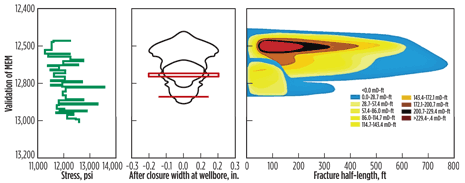 |
|
Fig. 2. Fracture geometry information generated by fracture pressure history matching of the mechanical earth model.
|
|
Integrated single-well modeling. Tracers and multiple production logs enabled the integration of production and fracture evaluations in single-well models. Production allocation techniques provided a unique pressure and rate history for each statistically relevant sand and stage in the five look-back wells. Then rate-transient analysis techniques provided quantitative estimates of reservoir effective permeability, effective fracture half-length, and average fracture conductivity across the four horizons and the entire field.
Production history matching indicated that productive fracture half-lengths increased with depth, with the longest being in the Rock Springs formation. Fracture modeling indicated that these half-length variations were dictated by the stress profile and exacerbated by high-viscosity fluid systems. Plotting conductivity estimates from production matching against depth and closure stress also indicated that fracture half-lengths were sensitive to proppant type.
Rock Springs formation. Single-well modeling showed that the deepest reservoirs—in the Lower Rock Springs formation—exhibited the second highest average permeability (0.007 mD), and accounted for 40%–70% of the gas production. The Lower and Middle Rock Springs showed good length extension (more than 220-ft productive length), while the Upper Rock Springs exhibited low productivity and poor containment. Modeling suggested that separating the Middle and Upper Rock Springs, using only high-strength proppant, and introducing an alternative hybrid completion design would improve productivity.
Almond formation. Modeling also showed that the existing practice of fracture stimulating the fluvial and marine sands of the Almond formation in a single stage would achieve limited effect, due to the presence of coals with high net pressures. While permeabilities within the marine and fluvial units were similar, productive half-lengths varied significantly (from 9 ft to 330 ft). Recommendations were made to modify the potassium chloride (KCl) content and to separate these sands into two stages.
Lewis formation. Finally, very small, high-permeability sands (0.008–0.02 mD) of the Lewis formation accounted for 10%–40% of the commingled production from the five look-back wells. Modeling indicated that these sands were understimulated for two reasons. One was short fracture half-lengths, caused by high-viscosity fluids that created height growth. The other was low conductivity, which was caused by low proppant concentrations (due to fear of screenouts) and proppant selection (due to high effective stresses). Suggested improvements included increasing proppant concentrations, using larger and higher-strength proppants, and initiating fracture stimulation with lower-viscosity fluids or lower job pump rates.
PHASE TWO: LOOK-FORWARD STUDY
Based on the integrated modeling described above, a single-well model was developed to represent P10, P50 and P90 cases, capturing the possible range of production upside that could result from completion improvements in Wind Dancer field. Forecasts indicated considerable upside potential.
Implementing completion changes. Once multilayer optimization opportunities had been quantified, changes were implemented experimentally in four look-forward wells. Previously drilled and logged but not completed, these wells were selected due to their proximity to the five producing wells used in the look-back study.
To enhance fracture geometry, hybrid treatments were introduced in lower-quality reservoirs to reduce height growth, and entry and staging were limited according to stress changes. To increase fracture conductivity, KCl concentrations were increased in specific zones, high sand concentrations were introduced, and only 20/40 high-strength proppants were used. To efficiently test completion changes without creating any commingling issues, only half of each wellbore was completed—two wells in the Rock Springs, and two in the Almond and Lewis.
Quantifying the impact. Extensive post-treatment testing was performed to quantify the actual impact of optimization efforts. Multiple production logs were run to identify the percentage contributions of various zones. Rate-transient analysis and history matching indicated that conductivities and fracture half-lengths increased by an average of 43% and 10%, respectively, in the Rock Springs, 21% and 26% in the Almond, and 35% and 10% in the Lewis.
Based on 220 days of cumulative production, half-well completions in the four look-forward wells exceeded the performance of the field’s historic, full-wellbore P10, P50 and P90 completions, Fig. 3. One half-well completion, for example, exceeded the field’s P90 full-well completions by 25%. Another exceeded the field’s P50 full-well completions by 10%. A third half-well completion exceeded the field’s P10 full-well completions by 52%. Although the average reservoir quality index of the look-forward wells was slightly higher than that of the look-back wells, analysis of variance indicated that the differences were statistically insignificant. Therefore, improvements in well productivity were directly related to strategic changes in completion design, not to superior reservoir quality.
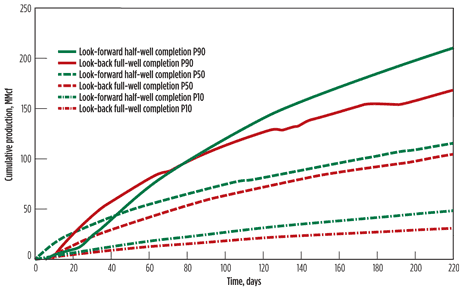 |
|
Fig. 3. Comparison of half-well completions in the look-forward study with full-well completions in the look-back study after 220 days.
|
|
Knowledge and new best practices gained from this comprehensive, multidisciplinary study will guide the completion of additional wells in Wind Dancer field that are currently behind casing.
APPLICATIONS OF SINGLE-WELL PREDICTIVE MODELING
Along with an appropriate data-gathering strategy, the single-well modeling workflow described here is much faster, less costly, and more technically quantifiable than the traditional learning curve many operators experience in unconventional plays with multistage fracture completions. Instead of relying on trial and error, spreadsheets, simple statistics or production history matching alone, integrated predictive modeling workflows include rigorous fracture modeling as well. While a multi-well reservoir simulation study may be the ideal, single-well evaluations are smaller and more manageable. Depending on field size and reservoir variability, it may be necessary to conduct evaluations in different parts of an asset.
This type of study is economically feasible not only during an asset’s production phase, but also earlier in exploration or field development to help determine optimal well spacing. Since permeabilities and fracture half-lengths differ by horizon, drainage patterns may differ considerably as well, Fig. 4. This can have a major impact on how closely wells should be drilled, on job size, and on how completions should be staged to achieve maximum production without depletion effects, wellbore stability problems or challenges to fracture implementations down the road. It is important not only to be able to predict fracture geometry and conductivity, but also to understand when desired optimization objectives simply cannot be achieved due to either reservoir quality or geomechanical constraints. In either case, integrated predictive models can save enormous amounts of wasted time, money and effort.
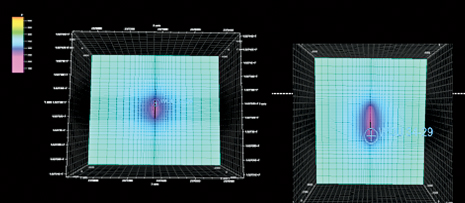 |
|
Fig. 4. Comparison of drainage aspect ratios for the Lewis (left) and Almond sands.
|
|
Although this workflow was used in a tight gas development program, it would also be applicable to tight oil and even high-permeability reservoirs involving planar fracture completions in multiple producing zones with production logs. 
ACKNOWLEDGEMENTS
This article was prepared in part from SPE 137126 presented at the SPE Tight Gas Completions Conference in San Antonio, Texas, Nov. 2–3, 2010.
THE AUTHORS
|
|
ANDREW CLAUGUS is a Reservoir and Completions Engineer with GMT Exploration Company in Denver, Colorado. After earning a BS degree in chemical engineering from Case Western Reserve University, he earned a master’s degree in petroleum engineering from the Colorado School of Mines. Mr. Claugus joined GMT six years ago as a production engineer. In his current role, he performs all company reservoir and completion engineering functions, and is involved in the economic assessment of US prospects and acquisitions.
|
|
|
MIKE DILLI is Vice President of Exploration at GMT Exploration Company. He graduated from Fort Lewis College in Durango, Colorado.
|
|
|
BILU CHERIAN is Schlumberger’s Production and Stimulation Engineering Technical Manager for the Western US, based in Denver. He has 10 years’ experience with Schlumberger and has worked on several US and international production and completion engineering projects as well as managing large integrated development projects in the Western US. Mr. Cherian has a bachelor’s degree in chemical engineering from RMIT University in Melbourne, Australia, and an MSc degree in chemical engineering from the University of Houston.
|
|
|
DOMINGO MATA is a Production and Stimulation Engineer for Schlumberger based in Denver. He has been with Schlumberger for over three years and began his career in Vernal, Utah, as a Fracturing Field Engineer. Mr. Mata has worked on various stimulation and completion projects evaluating vertical multilayer and horizontal gas and shale oil plays. He holds a BS degree in mechanical engineering from the Metropolitan University in Caracas, Venezuela, and an MS degree in petroleum engineering from West Virginia University.
|
|
|
JASON SITCHLER is a Geomechanics Engineer for Schlumberger Data and Consulting Services in Denver. He earned a BS degree in geology from Texas A&M University and an MS degree in structural geology from the Pennsylvania State University. His current role focuses on mechanical earth modeling for improved wellbore stability and hydraulic fracture design.
|
|
|
SAMER ALATRACH is the Petrophysics Team Leader for Schlumberger Data and Consulting Services in Denver. He has 20 years’ experience with Schlumberger and has worked on several US and international facilities. He was also the technical manager for the company’s wireline operations in the Eastern US. Mr. Alatrach hold a bachelor’s degree in civil and petroleum engineering from Kuwait University.
|
|
|
JESSICA NEUMILLER is a Production and Stimulation Engineer for Schlumberger. She began her career with the company three years ago as a Production Engineer and has worked on various stimulation and completion projects evaluating vertical multilayer and horizontal gas and shale oil plays. Ms. Neumiller has a BS degree in environmental engineering and an MS degree in petroleum engineering from the Colorado School of Mines.
|
|
|
MARADEN PANJAITAN is a Production and Stimulation Engineer for Schlumberger. He has more than 10 years’ experience with the company, starting as a field engineer in Rock Springs, Wyoming. Mr. Panjaitan later worked as an in-house engineer for several clients in Denver and in Calgary, Alberta. He holds a BS degree in mining and metallurgical engineering from the Bandung Institute of Technology in Indonesia. His current focus is production optimization in the Rocky Mountains and the Bakken formation.
|
|
| |
|







